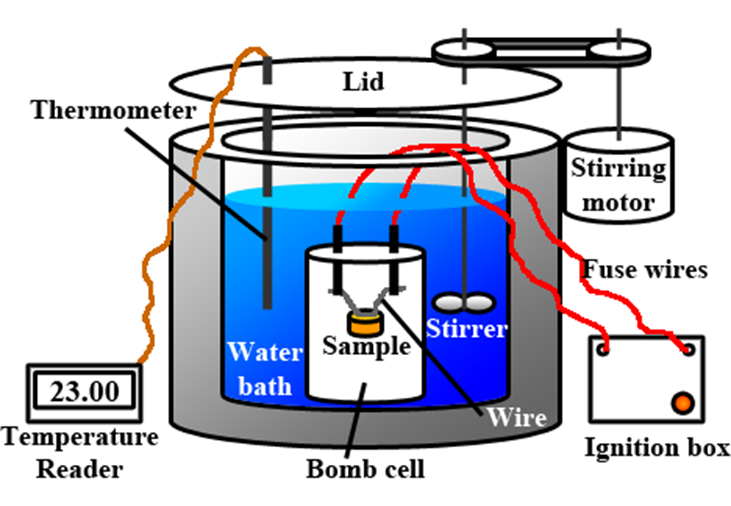
A $\,10g\,$piece of iron $\,(C = 0.45J/{g^o}C)\,$ at $\,{100^o}C\,$ is dropped into $\,25g\,$ of water $\,(C = 4.2J/{g^o}C)\,$ at $\,{27^o}C\,$ . Find the temperature of the iron and water system at thermal equilibrium.
A.$\,{30^o}C\,$
B.$\,{33^o}C\,$
C.$\,{40^o}C\,$
D.None of these
Answer
557.1k+ views
Hint:When two bodies of different temperatures are placed in physical contact with each other, the heat is transferred from the body with higher temperature to the body with lower temperature until thermal equilibrium is attained between them. According to the law of conservation of energy, heat loss of a system is equal to heat gained. This law is related to the principle of calorimetry.
Formula used: $\,q = mc\Delta t\,$
Complete step by step answer:
Let us first understand about calorimetry;
In order to quantify the heat transfer associated with changes in its states, such as physical changes or phase transitions under particular circumstances, the act or science of calculating changes in the state variables of a body is known as calorimetry. This is conducted with the help of a calorimeter.

Now, let us come to the question;
In order to calculate the temperature at thermal equilibrium we can use the below mentioned formula;
$\,q = mc\Delta t\,$
$\,q\,$ is heat transfer
$\,m\,$ is mass of the body
$\,c\,$ is specific heat of the body
$\,\Delta t\,$ is the change in the temperature
Firstly, let us calculate the heat that the water consumes and use that value derived to calculate their temperature at equilibrium as the heat loss is equal to heat gained as per the law of conservation of energy;
Heat loss by iron= Heat gained by water
Therefore, $\,q = mc\Delta t\,$
$\,m\,$of iron$\, = 10g\,$ and $\,m\,$ of water$\, = 25g\,$
$\,c\,$ of iron $\, = 0.45J/{g^o}C\,$ $\,c\,$ of water $\, = 4.2J/{g^o}C\,$
And, then while calculating the change in temperature, the temperature at equilibrium is represented as $\,{T_f}\,$.
$\,\Delta t\,$ of iron =$\,{T_f} - 373\,K\,$ $\because {100^o}C = (100 + 273)K\,$ and $\,\Delta t$ of water $\, = {T_f} - 300K\,\,\because \,{27^o}C = (27 + 273)K\,$
Therefore, substituting the above values in the equation we get,
$\,10 \times 0.45 \times ({T_f} - 373) = 25 \times 4.2 \times ({T_f} - 300)\,$
After simplifying we get;
$ \Rightarrow {T_f} = 303K\, $ or $\,{30^o}C\,$$\,\because 303K = {(303 - 273)^o}C\,$
Therefore, the temperature at thermal equilibrium is equal to $\,{30^o}C\,$ .Hence, option A is the correct answer for this question.
Note:In thermodynamics, the measurements obtained using the calorimetry principle describe a number of significant phenomena. Thermal equilibrium is derived from the zeroth thermodynamic law, which is the basis for the calculation of temperature.
Formula used: $\,q = mc\Delta t\,$
Complete step by step answer:
Let us first understand about calorimetry;
In order to quantify the heat transfer associated with changes in its states, such as physical changes or phase transitions under particular circumstances, the act or science of calculating changes in the state variables of a body is known as calorimetry. This is conducted with the help of a calorimeter.

Now, let us come to the question;
In order to calculate the temperature at thermal equilibrium we can use the below mentioned formula;
$\,q = mc\Delta t\,$
$\,q\,$ is heat transfer
$\,m\,$ is mass of the body
$\,c\,$ is specific heat of the body
$\,\Delta t\,$ is the change in the temperature
Firstly, let us calculate the heat that the water consumes and use that value derived to calculate their temperature at equilibrium as the heat loss is equal to heat gained as per the law of conservation of energy;
Heat loss by iron= Heat gained by water
Therefore, $\,q = mc\Delta t\,$
$\,m\,$of iron$\, = 10g\,$ and $\,m\,$ of water$\, = 25g\,$
$\,c\,$ of iron $\, = 0.45J/{g^o}C\,$ $\,c\,$ of water $\, = 4.2J/{g^o}C\,$
And, then while calculating the change in temperature, the temperature at equilibrium is represented as $\,{T_f}\,$.
$\,\Delta t\,$ of iron =$\,{T_f} - 373\,K\,$ $\because {100^o}C = (100 + 273)K\,$ and $\,\Delta t$ of water $\, = {T_f} - 300K\,\,\because \,{27^o}C = (27 + 273)K\,$
Therefore, substituting the above values in the equation we get,
$\,10 \times 0.45 \times ({T_f} - 373) = 25 \times 4.2 \times ({T_f} - 300)\,$
After simplifying we get;
$ \Rightarrow {T_f} = 303K\, $ or $\,{30^o}C\,$$\,\because 303K = {(303 - 273)^o}C\,$
Therefore, the temperature at thermal equilibrium is equal to $\,{30^o}C\,$ .Hence, option A is the correct answer for this question.
Note:In thermodynamics, the measurements obtained using the calorimetry principle describe a number of significant phenomena. Thermal equilibrium is derived from the zeroth thermodynamic law, which is the basis for the calculation of temperature.
Recently Updated Pages
Master Class 11 Business Studies: Engaging Questions & Answers for Success

Master Class 11 English: Engaging Questions & Answers for Success

Master Class 11 Computer Science: Engaging Questions & Answers for Success

Master Class 11 Social Science: Engaging Questions & Answers for Success

Master Class 11 Maths: Engaging Questions & Answers for Success

Master Class 11 Biology: Engaging Questions & Answers for Success

Trending doubts
Differentiate between an exothermic and an endothermic class 11 chemistry CBSE

10 examples of friction in our daily life

One Metric ton is equal to kg A 10000 B 1000 C 100 class 11 physics CBSE

Difference Between Prokaryotic Cells and Eukaryotic Cells

State the laws of reflection of light

Explain zero factorial class 11 maths CBSE




